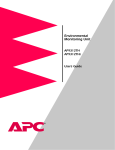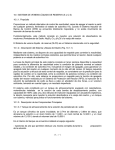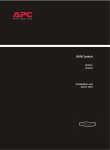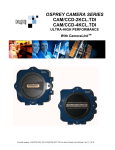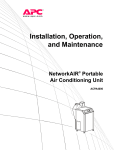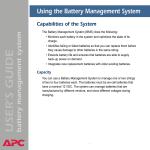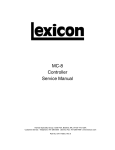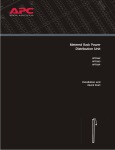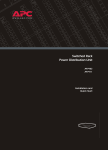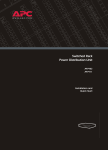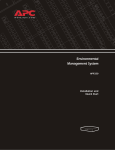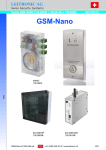Download American Power Conversion AP9312TH User's Manual
Transcript
Environmental Monitoring Unit Management Peripheral AP9312TH AP9312THi Installation and Quick Start Manual ® This manual is available in English on the enclosed CD. ❖❖❖ Dieses Handbuch ist in Deutsch auf der beiliegenden CD-ROM verfügbar. ❖❖❖ Este manual está disponible en español en el CD-ROM adjunto. ❖❖❖ Ce manuel est disponible en français sur le CD-ROM ci-inclus. Contents Introduction . . . . . . . . . . . . . . . . . . . . . . . . . . . . . 1 Features 1 Product inventory 2 Additional probes 3 Please recycle 3 Your inspection and warranty responsibilities 3 Additional documentation 3 Installation . . . . . . . . . . . . . . . . . . . . . . . . . . . . . . 4 Installing outside an enclosure 4 Installing in an enclosure 4 Connecting the probe(s) 5 Connection process: overview 6 Connecting dry contact devices 6 Contact Sensors . . . . . . . . . . . . . . . . . . . . . . . . . . . 7 Selecting sensors 7 Sensor zone description 8 Connection information 9 Multiple sensors in a zone 9 Example of a typical hookup 10 Quick Configuration . . . . . . . . . . . . . . . . . . . . . . 11 Required and optional settings 11 Configuring TCP/IP settings 11 Accessing the unit 14 Verifying configuration 14 Warranty Information . . . . . . . . . . . . . . . . . . . . . 15 Limited warranty 15 Obtaining service 15 Warranty limitations 15 i Contents continued Troubleshooting . . . . . . . . . . . . . . . . . . . . . . . . . 16 Maintenance 16 Correcting problems 16 If problems persist 17 Specifications . . . . . . . . . . . . . . . . . . . . . . . . . . . . 18 Electrical specifications 18 Physical specifications 18 Environmental specifications 19 Approvals 19 Radio Frequency Interference 19 Life-Support Policy . . . . . . . . . . . . . . . . . . . . . . . . 20 General policy 20 Examples of life-support devices 20 ii Introduction Features American Power Conversion’s stand-alone Environmental Monitoring Unit (AP9312TH and AP9312THi) continuously senses temperature and humidity and monitors contacts. You can control the unit through Web, Control Console, or SNMP interfaces. Additional features include: • Four zones of contact monitoring, each of which supports both normally open and normally closed contacts. • Compatible sensors for fire, water, smoke, unauthorized entry, physical security, or other external conditions that can be measured by contact closure. • Probes that can report temperature from 0 to 60° C (32 to 140° F) and relative humidity levels from 10% to 90%. • Two levels of user access: – Administrator – Device Manager • Brackets for mounting the unit in an APC NetShelter enclosure or other standard (EIA-310-D) 19-inch rack. • E-mail notification for abnormal contact conditions or out-of-range temperature and humidity. • Basic and MD5 authentication password security. Continued on next page 1 Introduction, continued Product inventory ! Rack-mount brackets with 4 flat-head screws (870-8213A and 870-8183) " AC power adapter # Hook and loop probe fasteners $ Combined temperature and humidity probe (AP9512TH) % Configuration cable (940-0120) & Environmental Monitoring Unit ' Detachable screw terminal connector for contact monitoring Continued on next page 2 Introduction, continued Additional probes To order a second temperature and humidity probe (AP9512TH), call APC Customer Support at a number listed on the back cover of this manual. Please recycle The shipping materials for the Environmental Monitoring Unit are recyclable. Please save them for later reuse or dispose of them appropriately. Your inspection and warranty responsibilities Inspect the Environmental Monitoring Unit immediately, and notify the carrier and the seller if there is any shipping damage. Additional documentation This Installation and Quick Start Manual and the User’s Guide are available in PDF format on the supplied CD and at the Web site http://www.apcc.com/support. The User’s Guide contains additional information about the following: Fill out and return the enclosed warranty card before you begin using the unit. • • • • • • management interfaces user accounts menu options e-mail security SNMP Note: The latest firmware versions are also available at http://www.apcc.com 3 Installation Installing outside an enclosure To install the Environmental Monitoring Unit outside an enclosure, place it on a flat surface in a protected area with adequate air flow and minimal dust. Do not operate the unit where temperature and humidity are outside the limits specified on page 19. Installing in an enclosure To install the Environmental Monitoring Unit in a NetShelter enclosure or other standard (EIA-310-D) 19-inch rack: 1. Attach the rack-mount brackets (870-8213A and 870-8183) to the unit using the four flat-head screws. 2. Insert caged nuts (provided with the enclosure) on the vertical mounting rails at the location you choose for the unit-bracket assembly in the enclosure. 3. Align the assembly’s brackets with the caged nuts in Step 2. Continued on next page 4 Installation, continued Installing in an enclosure, continued 4. Attach the assembly tightly to the enclosure using four mounting screws and four plastic cup washers (provided with the enclosure). Connecting the probe(s) 1. Connect the supplied probe (AP9512TH) to one of the probe connectors on the unit. Seat the probe connector firmly, and connect the second probe (if you have one). 2. Using the supplied hook and loop fasteners, if needed, place each probe in an area that is within the environmental limits specified on page 19. The location must be free from direct sunlight, excessive moisture (such as dew), dust, chlorine gas, and insecticides. Do not cover any of the probe’s ventilation holes. 3. Connect the supplied power adapter to the power port labeled 24VDC on the front panel of the unit. Continued on next page 5 Installation, continued Connection process: overview You must perform two procedures to set up contact monitoring. Connecting dry contact devices To connect dry contact devices to the Environmental Monitoring Unit: • See “Contact Sensors” on page 7 to select and connect contact sensors. • See “Connecting dry contact devices” on this page. 1. Connect contact closure sensors to the removable screw terminal block as described in “Contact Sensors” starting on page 7. 2. The connector accepts wire sizes from 14 AWG (1.6 mm2) to 26 AWG (0.4 mm2). Remove 0.25" (6 mm) of the wire’s insulation. 3. Connect the screw terminal block to the unit’s Sensor Zones connector. Following is an example of a completed installation: To complete the setup, see “Quick Configuration” on page 11. 6 Contact Sensors Selecting sensors To monitor circuits that have no voltage potential of their own, you can use any normally open (NO) or normally closed (NC) dry contact sensors. These sensors include: • • • • • • Magnetic contact switches Window foils Tamper switches Heat detectors Water sensors Pressure sensors Note: Connecting sensor inputs to circuits other than dry closure circuits voids the warranty and may damage to the unit. To monitor sensors that require power, the Environmental Monitoring Unit provides 12 VDC at up to 60 mA at pins 1 and 2 of the Sensor Zones connector. These sensors include: • Passive infrared (body heat) detectors • Smoke sensors • Photo relay detectors For more information on types of sensors you can use with the unit, call APC Customer Support at a number listed on the back cover of this manual. Continued on next page 7 Contact Sensors, continued Sensor zone description The following figure shows the screw terminal connector and the connector pins with their associated zones. The following table describes the zone associated with each connector pin. Sensor Zones Connector Pinout Pin Function 1 Power supply, +12 VDC nominal, 60 mA maximum 2 Power supply ground and normally open connection for all zones 3 Zone 1 common 4 Zone 1 normally closed 5 Zone 2 common 6 Zone 2 normally closed 7 Zone 3 common 8 Zone 3 normally closed 9 Zone 4 common 10 Zone 4 normally closed Continued on next page 8 Contact Sensors, continued Connection information The Environmental Monitoring Unit supports normally open and normally closed loop systems and allows mixing of normally open and normally closed sensors on any zone: Note: Do not connect the unit’s sensors with sensors from any other system. Multiple sensors in a zone To use more than one sensor on a zone, connect normally open sensors in parallel and normally closed sensors in series: To avoid receiving alarms for unused zones, install a jumper wire between the COM connector and NC connector of each unused zone. Continued on next page 9 Contact Sensors, continued Example of a typical hookup 10 In this example: • Zone 1 is a normally-closed zone with power for the passive infrared detector supplied by the Environmental Monitoring Unit. • Zone 2 is a normally open zone. • Zone 3 combines normally open and normally closed. • Zone 4 is not used. Quick Configuration Required and optional settings You must configure the following network settings of the Environmental Monitoring Unit before it can function on a network. • IP address of the unit • Subnet Mask • IP address of the Default Gateway No further configuration is required. The remaining properties of the unit have default settings. However, you may want to customize settings for your application. See “Managing the Unit” in the User’s Guide (usrguide.pdf). Configuring TCP/IP settings Choose the configuration method that matches your environment: • If you are using Windows 95, Window 98, or Windows NT, see “Through the Management Card Wizard” on this page. • If you are not using a Windows-based platform, or if you require direct serial configuration, see “Serially through the Control Console” on page 12. • If you are a network administrator using a computer connected to the local subnet, see “Over the Network by ARP” on page 13. • If you are a network administrator using BOOTP, see “Over the Network by BOOTP” on page 13. Through the Management Card Wizard. The Environmental Monitoring Unit contains a management card that provides the network interface. On a Windows 95, Windows 98, or Windows NT 4.0 workstation, the Management Card Wizard provides a quick way to configure all management card settings, including TCP/IP settings. To access the Management Card Wizard, run the program setup.exe on the CD-ROM supplied with the unit, and follow the on-screen instructions. Continued on next page 11 Quick Configuration, continued Configuring TCP/IP settings, continued Serially through the Control Console. If you are not using a Windows-based platform, or if you require direct serial configuration, use a Probe port to configure the TCP/IP settings of the Environmental Monitoring Unit’s management card: 1. Connect the supplied configuration cable (940-0120) to an available serial port on your computer and to one of the Probe ports on the front panel of the unit. 2. Disable PowerChute plus, UNIX Respond, or any other service that uses the serial port on the computer. 3. Run a terminal emulator such as Windows HyperTerminal. 4. Configure the appropriate serial port with the following settings: 2400 bps, no parity, 8 data bits, 1 stop bit, and no flow control. Note: Some terminal emulators such as HyperTerminal require that you disconnect and reconnect in order for the new serial settings to take effect. 5. From your computer, press ENTER until the user name prompt appears. 6. Enter the default user name and password (apc for both). 7. On the Main menu, choose Network. 8. On the Network menu, choose TCP/IP. 9. Within the TCP/IP menu: a. Disable BOOTP. b. Accept changes. c. Set a valid IP address, Subnet Mask and Default Gateway for your network. d. Accept changes e. Press ESC until the Main menu appears. f. From the Main menu, select Logout. Note: The new settings take effect when you log out. Continued on next page 12 Quick Configuration, continued Configuring TCP/IP settings, continued Over the Network by ARP. To configure the Environmental Monitoring Unit’s TCP/IP settings using ARP (Address Resolution Protocol): 1. Deploy the unit, and connect it to the network. 2. From a command prompt on a computer connected to the local subnet, type arp -s, the IP address of the Management Card, and the MAC address. For example: arp -s 159.215.240.22 00-c0-b7-78ad-90 Note: For the MAC address, see the Quality Assurance slip, the TCP/IP menu of the Control Console, or the label on the bottom of the unit. 3. Type telnet and the IP address of the Management Card. For example: telnet 159.215.240.22 4. Log in. The default user name and password are both apc. 5. Configure the Subnet Mask and Default Gateway in the TCP/IP section of the Network menu. Over the Network by BOOTP. BOOTP is enabled by default. Use a BOOTP server to configure the Environmental Monitoring Unit’s TCP/IP settings: 1. Enter the unit’s MAC address, IP address, Subnet Mask, default Gateway, and optional bootup filename. Note: For the MAC address, see the Quality Assurance slip, the TCP/IP menu of the Control Console, or the label on the bottom of the unit. 2. The BOOTP server provides network settings to the unit. If you specified a bootup file name, the unit attempts to transfer that file, first from a TFTP server and then from an FTP server on the same computer as the BOOTP server. The unit assume all settings in the bootup file. You can then configure other settings for the unit remotely using the Telnet, Web, or SNMP interfaces. Note: To create the bootup file use the Management Card Wizard. Continued on next page 13 Quick Configuration, continued Accessing the unit You can access the Environmental Monitoring Unit by using a Web browser, Telnet, or SNMP. Through a Web browser. 1. From the browser, enter the unit’s System IP address or its DNS name (if a DNS name is configured). 2. Log on to the unit. The default User Name and Password are apc (lowercase). Through Telnet. 1. Type telnet and the System IP address of the unit. 2. Log on to the unit. The default User Name and Password are apc (lowercase). Through SNMP. The default read-only community name is public, and the default read/write community name is private. Verifying configuration To confirm the basic operation of the Environmental Monitoring Unit: 1. Log on to the unit, and select Environmental Monitoring Status from the main menu. 2. Confirm the operation of the probe. With the probe properly connected, the unit reports accurate temperature and humidity. If the probe is not properly connected, the unit reports very low temperature and humidity values. 3. Confirm contact sensing. Activate each sensor in turn, according to the recommendation of the sensor manufacturer, and verify that it operates as expected. 14 Warranty Information Limited warranty American Power Conversion (APC) warrants the Environmental Monitoring Unit to be free from defects in materials and workmanship for a period of two years from the date of purchase. Its obligation under this warranty is limited to repairing or replacing, at its own sole option, any such defective products. This warranty does not apply to equipment which has been damaged by accident, negligence, or misapplication or has been altered or modified in any way. This warranty applies only to the original purchaser. Obtaining service To obtain service under warranty you must obtain a returned material authorization (RMA) number from APC or a designated APC service center. Products must be returned to APC or an APC service center with transportation charges prepaid and must be accompanied by a brief description of the problem encountered and proof of date and place of purchase. For further information on obtaining service, see “If problems persist” on page 17. Warranty limitations Except as provided herein, American Power Conversion makes no warranties, express or implied, including warranties of merchantability and fitness for a particular purpose. Some jurisdictions do not permit limitation or exclusion of implied warranties; therefore, the aforesaid limitation(s) or exclusion(s) may not apply to the purchaser. Except as provided above, in no event will APC be liable for direct, indirect, special, incidental, or consequential damages arising out of the use of this product, even if advised of the possibility of such damage. Specifically, APC is not liable for any costs, such as lost profits or revenue, loss of equipment, loss of use of equipment, loss of software, loss of data, costs of substitutes, claims by third parties, or otherwise. This warranty gives you specific legal rights and you may also have other rights which vary from state to state. 15 Troubleshooting Maintenance The Environmental Monitoring Unit requires periodic maintenance. • To remove any visible buildup of dust from the temperature and humidity probe, gently brush or vacuum the probe. Do not blow any type of compressed gas into the probe. • For maintenance of contact sensors, see the sensor manufacturer’s product literature. Correcting problems Problem Possible Cause Solution Constant alarm on one or more unused zones. No jumper wires for unused zones. For each unused zone, connect a wire between the COM and NC terminals. Constant low temperature and humidity readings. 12 VDC supply (pin 1) shorted to ground or overloaded. Correct the short circuit: examine all sensors that use the 12 VDC power supply. Incorrect sensor readings. Improper sensor wiring. Correct the sensor wiring. (See “Contact Sensors” on page 7.) Continual reports of low temperature or humidity. Probe not connected properly. Connect the probe properly. (See “Connecting the probe(s)” on page 5.) Continued on next page 16 Troubleshooting, continued If problems persist If a problem is not mentioned in “Correcting problems” on page 16, or if the problem persists: 1. Note the serial number and date of purchase of the Environmental Monitoring Unit, and contact Customer Support at a phone number on the back cover of this manual. A technician will try to help you solve the problem by phone. 2. If you must return the unity, the technician will give you a return material authorization (RMA) number. If the warranty expired, you will be charged for repair or replacement of the unit. a. Pack the unit carefully. The warranty does not cover damage sustained in transit. Enclose a letter with your name, address, RMA number, and daytime phone number; a copy of the sales receipt; and a check as payment, if applicable. b. Mark the RMA number clearly on the outside of the shipping carton. c. Return the unit by insured, prepaid carrier to the address provided by the Customer Support technician. 17 Specifications Electrical specifications Item Input voltage, nominal Maximum total current draw Specification 24 VDC 0.1 A @ 24 VDC (exclusive of any attached sensors) Temperature accuracy ± 2 ° C (± 3.6 ° F), from 0 to 40 ° C (32 to 104 ° F) Humidity accuracy ± 8 % RH, 10 to 90% RH, at 25 ° C (77 ° F) ± 8 % RH, 30 to 80% RH, from 15 to 30 ° C (59 to 95 ° F) Sensor zone input response time 100 ms 12 VDC nominal, 60 mA Power output maximum, ground-referenced Physical specifications Item Specification Size (height × width × depth) 1.73 × 5.53 × 6.75 in 4.39 × 14.0 × 17.3 cm Weight 1.8 lb 0.8 kg Shipping weight 4.6 lb 2.1 kg Continued on next page 18 Specifications, continued Environmental specifications Item Specification Elevation: Operating: Storage: 0 to 10,000 ft (0 to 3000 m) 0 to 50,000 ft (0 to 15 000 m) Temperature: Operating: Storage: 0 to 40° C (32 to 104° F) 0 to 45° C (32 to 113° F) Probe operating temperature 0 to 60° C (32 to 140° F) Operating humidity 0 to 95%, non-condensing Approvals Item EMC verification Electromagnetic immunity Radio Frequency Interference Approval FCC, VCCI, DOC, and EN55022: Class A EN50082-1 verified This equipment has been tested and found to comply with the limits for a Class A digital device, pursuant to part 15 of the FCC Rules. These limits provide reasonable protection against harmful interference when the equipment is operated in a commercial environment. This equipment generates, uses, and can radiate radio frequency energy and, if not installed and used in accordance with this manual, may cause harmful interference to radio communications. Operation of this equipment in a residential area is likely to cause harmful interference. The user will bear sole responsibility for correcting such interference. This Class A digital apparatus complies with Canadian ICES003. Cet appareil numérique de la classe A est conforme à la norme NMB-003 du Canada. 19 Life-Support Policy General policy As a general policy, American Power Conversion (APC) does not recommend the use of any of its products in the following situations: • life-support applications where failure or malfunction of the APC product can be reasonably expected to cause failure of the life-support device or to significantly affect its safety or effectiveness. • direct patient care. APC will not knowingly sell its products for use in such applications unless it receives in writing assurances satisfactory to APC that (a) the risks of injury or damage have been minimized, (b) the customer assumes all such risks, and (c) the liability of American Power Conversion is adequately protected under the circumstances. Examples of life-support devices The term life-support device includes but is not limited to neonatal oxygen analyzers, nerve stimulators (whether used for anesthesia, pain relief, or other purposes), autotransfusion devices, blood pumps, defibrillators, arrhythmia detectors and alarms, pacemakers, hemodialysis systems, peritoneal dialysis systems, neonatal ventilator incubators, ventilators (for adults or infants), anesthesia ventilators, infusion pumps, and any other devices designated as “critical” by the U.S. FDA. Hospital-grade wiring devices and leakage current protection may be ordered as options on many APC UPS systems. APC does not claim that units with this modifications are certified or listed as hospital-grade by APC or any other organization. Therefore these units do not meet the requirements for use in direct patient care. 20 Declaration of Conformity Application of Council Directives 89/336/EEC Standards to Which Conformity is Declared EN55022, EN55024 Manufacturer’s Name and Address American Power Conversion 132 Fairgrounds Road West Kingston, Rhode Island 02892 USA –or– American Power Conversion (A.P.C.) b.v. Ballybrit Business Park Galway, Ireland Importer’s Name and Address American Power Conversion (A.P.C.) b.v. Ballybrit Business Park Galway, Ireland Type of Equipment Management Peripheral Model Numbers AP9312THi Serial Numbers WA0001000000 and above Year of Manufacture 2000 onward We, the undersigned, hereby declare that the equipment specified above conforms to the above directives. St. Louis, MO February 16, 2000 Ted Eckert Regulatory Compliance Engineer Galway, Ireland February 16, 2000 Ray Ballard General Manager, Galway APC Worldwide Customer Support Customer support for this or any other APC product is available at no charge in any of the following ways: • Visit the APC Web site to find answers to frequently asked questions (FAQs), to access documents in the APC Knowledge Base, and to submit customer support requests. – http://www.apc.com (Corporate Headquarters) Connect to localized APC Web sites for specific countries, each of which provides customer support information. – http://www.apc.com/support/ Global support with FAQs, knowledge base, and e-support. • Contact an APC Customer Support center by telephone or e-mail. – Regional centers: . – • APC Headquarters (U.S. and Canada) (1) (800) 800-4272 (toll free) Latin America (1) (401) 789-5735 (United States) Europe, Middle East, Africa (353) (91) 702020 (Ireland) Japan (03) 5434-2021 Guidance 3 Local, country-specific centers: go to http://www.apc.com/support/ contact for contact information. Contact the APC representative or other distributor from whom you purchased your APC product for information on how to obtain local customer support. Entire contents copyright © 2001 American Power Conversion. All rights reserved. Reproduction in whole or in part without permission is prohibited. APC is a registered trademark of American Power Conversion Corporation. All other trademarks, product names, and corporate names are the property of their respective owners and are used for informational purposes only. 990-0814B 08/2001



























